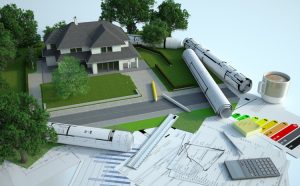
Rachel and Len have lived in Northern Virginia for their entire lives. During their 50 years of marriage, they raised three children, who all also reside in the Old Dominion state. They want to be near their children and grandchildren for as long as possible, but realize they may need to move south a bit to make it affordable. Recently, they discovered something incredible mentioned in the Virginia Mercury — Virginia’s first 3D printed house is being built in Richmond! Could something affordable like this be the answer to their affordable retirement housing predicament?
As Rachel and Len have discovered, a revolutionary way to build homes is coming to Virginia that could be a potential solution to constructing more affordable houses. You may have heard of a 3D printer making small, plastic items for doll furniture and models, and even some small practical items, but 3D printers can also make life-size projects, including a 1,550-square-foot home planned for South Richmond.
The three-bedroom, two-bath home will be the first house in Virginia partially constructed using a 3D printer rather than lumber. The project is funded by a $500,000 grant from Virginia Housing, and will be designed by the Virginia Center for Housing Research at Virginia Tech and printed by Iowa-based construction company, AlquistWork. Work is slated to begin this week and will be completed in the fall. So, the first 3D-printed home for sale in Virginia is set to be on the market by October, roughly half as much time as it would take to construct a stick-built home.
How 3D Printing a House Works
Building exterior walls of the home using a giant pri
nter is different than traditional construction, but it is easier to understand than you might think, said Andrew McCoy, director of the Virginia Center of Housing Research at Virginia Tech, one of the partners in the project to build the home. He describes it to be “like we’re building a layer cake.” The 3D printing system places layers of concrete atop of one another. “It’s layer upon layer and, just like a layer cake, you have to worry about the consistency of each level,” he said. “You have to worry about how you are going to finish it. You have to worry about making sure that there’s all the ingredients, but baking is the critical part.”
Why 3D Printing is Being Used in Home Construction
3D construction should be able to provide a more affordable way to build homes while lowering costs at least $10 per square foot compared to a traditionally built home using lumber, according to Virginia Housing. Using 3D printing technology in home construction is faster, cheaper, and more sustainable than traditional construction, and it is more energy-efficient after the house is built, experts say. “The hope is that we can produce the home between $180,000 and $190,000, and we can sell them for $210,000 to $220,000, which is very affordable in that area.” McCoy said. Learn more about this house and 3D housing in Virginia in this Virginia Mercury article.
3D Housing is Helping Seniors in Other Parts of the Country
3D housing is already underway in other parts of the country. Tim Shea, 69, is one senior who is waiting to move into a new, 3D-printed house in the Austin, TX area. Shea is among a growing number of seniors in America who have struggled to keep affordable housing, and has most recently lived in an RV. He has arthritis and manages to get around with the aid of a walker. He said he “looks forward to giving up the steep ramp he’s had to negotiate when entering or exiting the RV he’s called home.” Read more about Tim and affordable 3D housing for seniors and others in the Austin area in this KHN article.
Affordable Housing is a Huge Worry for Many Seniors
3D housing and other affordable housing options will be incredibly helpful for more seniors and other low-income families than many people realize. According to a study led by the Harvard Joint Center for Housing Studies, there is a growing income disparity among Americans of older age. According to the study, the federal government considers housing affordable when a resident can spend 30% or less of income on it and those who spend more are “cost burdened.” “While many households now of retirement age have the means to age in place or move to other suitable housing, a record number are cost burdened and will have few affordable housing options as they age,” the analysis said. “In addition, many older renters are less well-positioned than homeowners because they have lower cash savings and wealth.
The study also shows the increasing homelessness among older adults. “Homelessness among people age 50 and older surged to 33.8% in 2017 from 22.9% in 2007. According to the study, those figures suggest the “need for affordable, accessible housing and in-home supportive services is therefore set to soar.”
“Housing insecurity has an impact in a person’s health and well-being. Financial pressures can also lead to depression and other physical problems,” the study added. The Center believes that options such as affordable 3D printed houses are “long overdue.”
Affordable Housing Options for Seniors
Senior housing can be extremely expensive, leaving seniors with no option but to spend the majority of their retirement savings on rent. Luckily, there are a couple affordable housing programs that can help you find an affordable place to reside for yourself or a loved one. Two affordable housing programs for seniors, through HUD, include the Low Income Housing Tax Credit (LIHTC) and Section 202 Supportive Housing Program, a program specifically for seniors over the age of 62.
For seniors who need care and assistance, my recent article on the subject describes different housing and care options available to seniors today. Unfortunately, these are not considered to be affordable housing options. In another article, we discussed Non-Traditional Living Options for Seniors, such as villages, co-housing, NORCs, and niche communities.
When More Care is Needed
Most seniors will want to stay in their home for as long as possible. However, if a loved one cannot live independently and he or she is showing signs that living alone is a strain, it may be time to consider other options.
Nursing home care in the DC Metro area costs between $12,000 to $15,000 a month, which can be catastrophic for most of us! Life Care Planning and Medicaid Asset Protection is the process of protecting assets from having to be spent down in connection with entry into assisted living or nursing home care, while also helping ensure that you and your loved ones get the best possible care and maintain the highest possible quality of life, whether at home, in an assisted living facility, or in a nursing home. To learn more, please contact us at any time for an initial consultation:
Fairfax Elder Law Attorney: 703-691-1888
Fredericksburg Elder Law Attorney: 540-479-143
Rockville Elder Law Attorney: 301-519-8041
DC Elder Law Attorney: 202-587-2797
Print This Page











